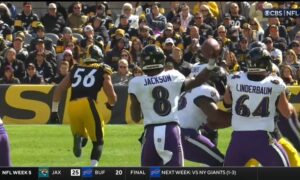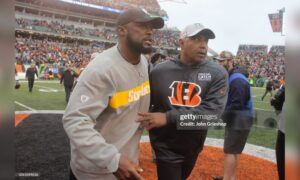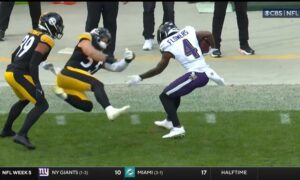By Matthew Marczi
Entering his seventh training camp as head coach of the Pittsburgh Steelers, Mike Tomlin decided to do things a little differently this year, something even veterans such as Larry Foote have said that they’ve never experienced before during a Steelers training camp: live tackling in 11-on-11 drills.
Foote, of course, also played under former head coach Bill Cowher, meaning that it has been some time since the Steelers last ran full contract drills in this manner, outside of the goal line drill, during training camp.
According to Tomlin, the idea behind the physical exhibitions is to get a better look at the young players on the roster. With the myriad restrictions limiting what teams can do during practice under the new Collective Bargaining Agreement—not to mention the expansion to 90-man offseason rosters—the player evaluation portion of coaches’ jobs has gotten harder.
“It’s just appropriate in today’s NFL”, Tomlin said after the first of these live contact drills. “We have off days. We only get a chance to practice once a day. There are fewer and fewer opportunities to sort themselves out. We’ve got some young guys. We’ve got to sort through a lot of young guys and we’ve got to take advantage of opportunities to show improvement. That is what it is about”.
Giving the young players the opportunity to put themselves on tape more through the live tackling sessions gives them a chance to jump out more; and, conversely, it also singles out those who shrink from the physical, competitive aspect of the game.
Veterans such as LaMarr Woodley and Troy Polamalu are held out of these drills, which is a shrewd and sensible move on many fronts. On the front end, of course, it minimizes the veterans’ exposure to potential injuries.
But more importantly, on the back end, it gives other players, such as undrafted outside linebacker Alan Baxter or fourth round safety Shamarko Thomas, some reps under live fire when they otherwise would not have the chance.
Today, for example, with Woodley sitting out the team portion of practices, Jarvis Jones got the opportunity to play on the first team at right outside linebacker, with Jason Worilds playing on the left side, where he actually made most of his career starts.
If the team intends for Jones to be a significant contributor on defense this season, then this is the drill to help him get comfortable. While there are reports that he expectedly has shown some moments of confusion and hesitation, he has also been able to showcase some of his playmaking skills, coming down with an interception of a Ben Roethlisberger pass after tipping it himself. It is plays like that, of course, that will earn him playing time during the season.
There are many benefits to the drill, which Tomlin has promised will continue this training camp as a means of getting more looks at the back end of the 90-man roster. As highlighted above, it gives players like Jones a chance to flash. But it also gives them the chance to make their mistakes and learn from them.
That is what happened to Thomas on Wednesday after he bit on an underneath route only to be beaten deep by the veteran Plaxico Burress for a 55-yard touchdown pass thrown by Bruce Gradkowski. You learn more from your mistakes than you do from your successes, and this live drill introduces plenty of what Tomlin likes to refer to as “teachable moments”.
And what better way to break in not only your new running back, but your new blocking scheme?
There are many reports that rookie back Le’Veon Bell has been able to flash some in the drill, reading the line for the right hole on a few outside zone plays during these first couple of days of padded practices. Perhaps it will also lessen the learning curve he faces when it comes to picking up the blitzer in pass protection.
Another added benefit of the drill is that it helps the defense better prepare for what they will face during the season. With the recent success of the Houston Texans, and Washington Redskins especially, in running the zone blocking scheme, other teams, such as the Steelers this offseason, are adopting elements of the zone into their own packages.
Many will remember how the Baltimore Ravens and the Texans were able to run all over the Steelers defense utilizing zone blocking during the 2011 season. Having the opportunity to practice against it—as well as the no huddle that teams like the New England Patriots employ often, which the Steelers are running more this camp—should give the defense a bigger edge against these offenses than they have had in the past.
More than anything, however, the live tackling drills are a tone setter, establishing a physical identity that the Steelers feel that they need to reconnect with this season after failing to advance in the playoffs in back to back years. The hope is that the tone set in drills such as these during camp will carry on into the season.
You can rest assured that if this season bears fruit, the live tackling drills will continue. After all, the rosters are not getting any smaller and the practice rules are not getting any more lenient, so if this is truly a means of getting a better look at some of the more unheralded players on the roster, there is no reason that it should be a one-time experiment.







